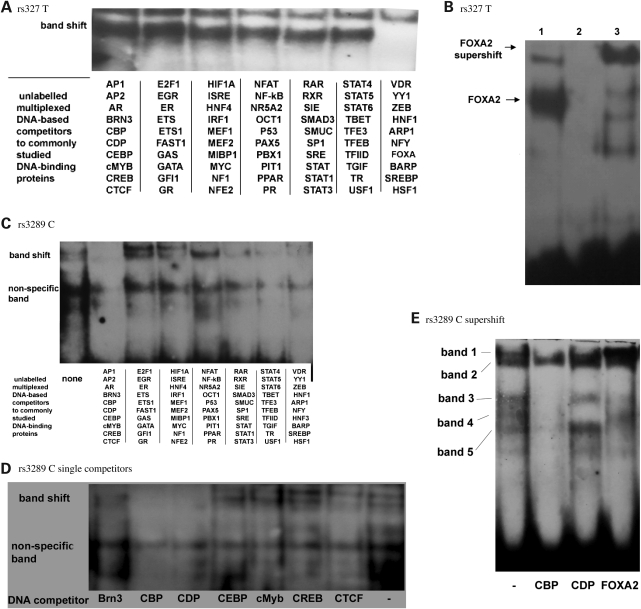Figure 4.
(A) MC-EMSA using cocktails of unlabelled DNA competitors to 70 well-characterized DNA-binding proteins, using the rs327 T allele probe and Huh7 nuclear extract. The final column of multiplexed competitors prevents binding of rs327 T DNA to the protein. (B) Supershift EMSA on rs327 T probe. The single competitors from the final column in 7(a) were run individually in a further EMSA, showing FOXA competitor resulted in competition (data not shown). To confirm FOXA binding, a supershift assay was carried out using an antibody to FOXA2. Lane 1 represents the shift produced by the FOXA2–DNA interaction, lane 2 includes unlabelled consensus DNA for FOXA competition, lane 3 demonstrates a supershift with the addition of a FOXA2 monoclonal antibody, confirming binding of FOXA2. (C) MC-EMSA using cocktails of unlabelled DNA competitors to 70 well-characterized DNA-binding proteins, using the rs3289 C allele probe and Huh7 nuclear extract. The first column of multiplexed competitors prevents binding of rs3289 C DNA to the protein. (D) The single competitors from the first column in 7(c) were run individually in a further EMSA, showing both CBP and CDP competitors resulted in competition. (E) Supershift against rs3289 C allele probe using antibodies for CBP, CDP and FOXA2 (as a negative control). Addition of antibody to CBP results in the elimination of bands 1, 3 and 4. Addition of antibody to CDP results in the elimination of band 4. A supershift is not observed, possibly due to hindrance from heterodimeric binding.

